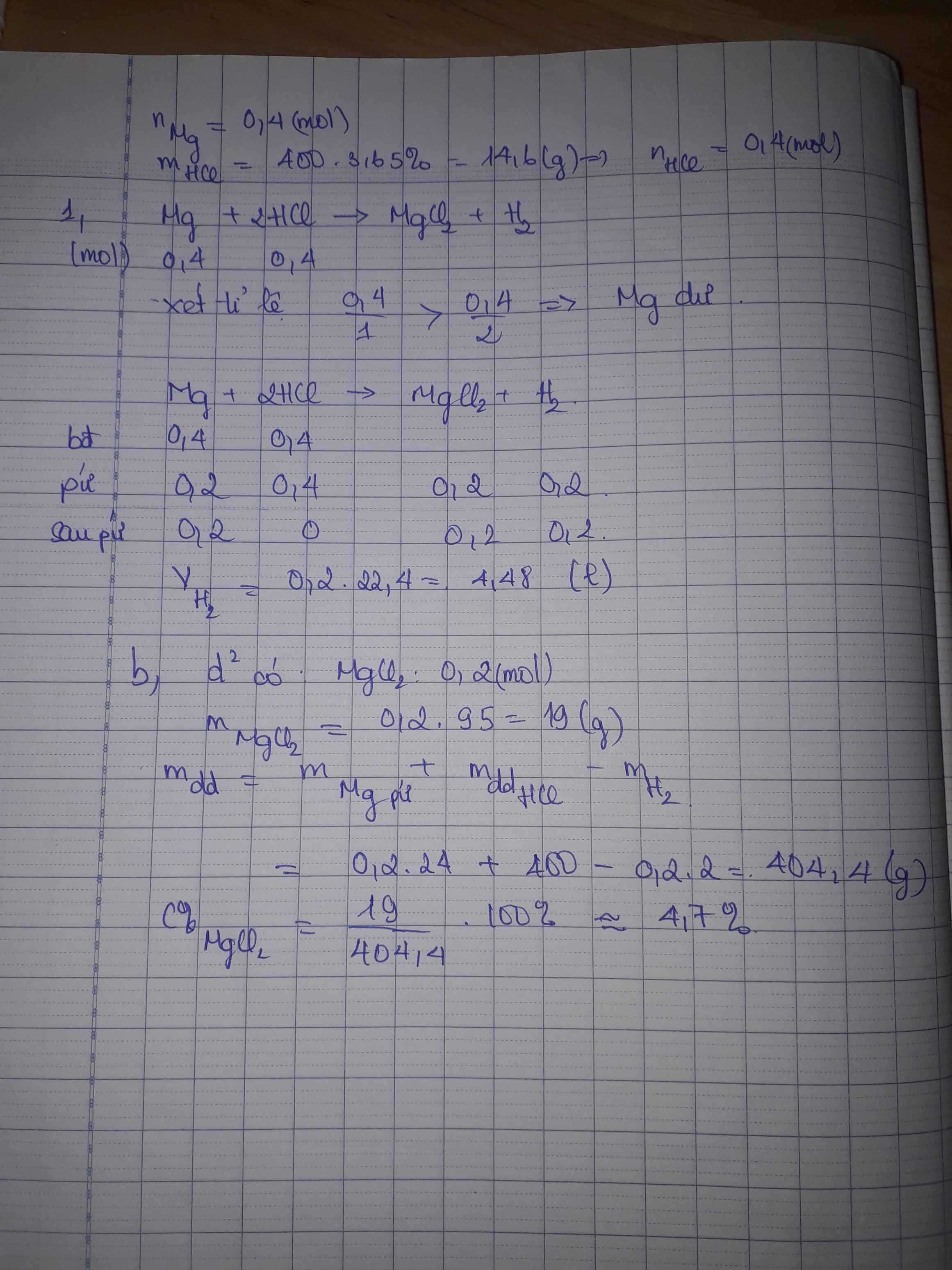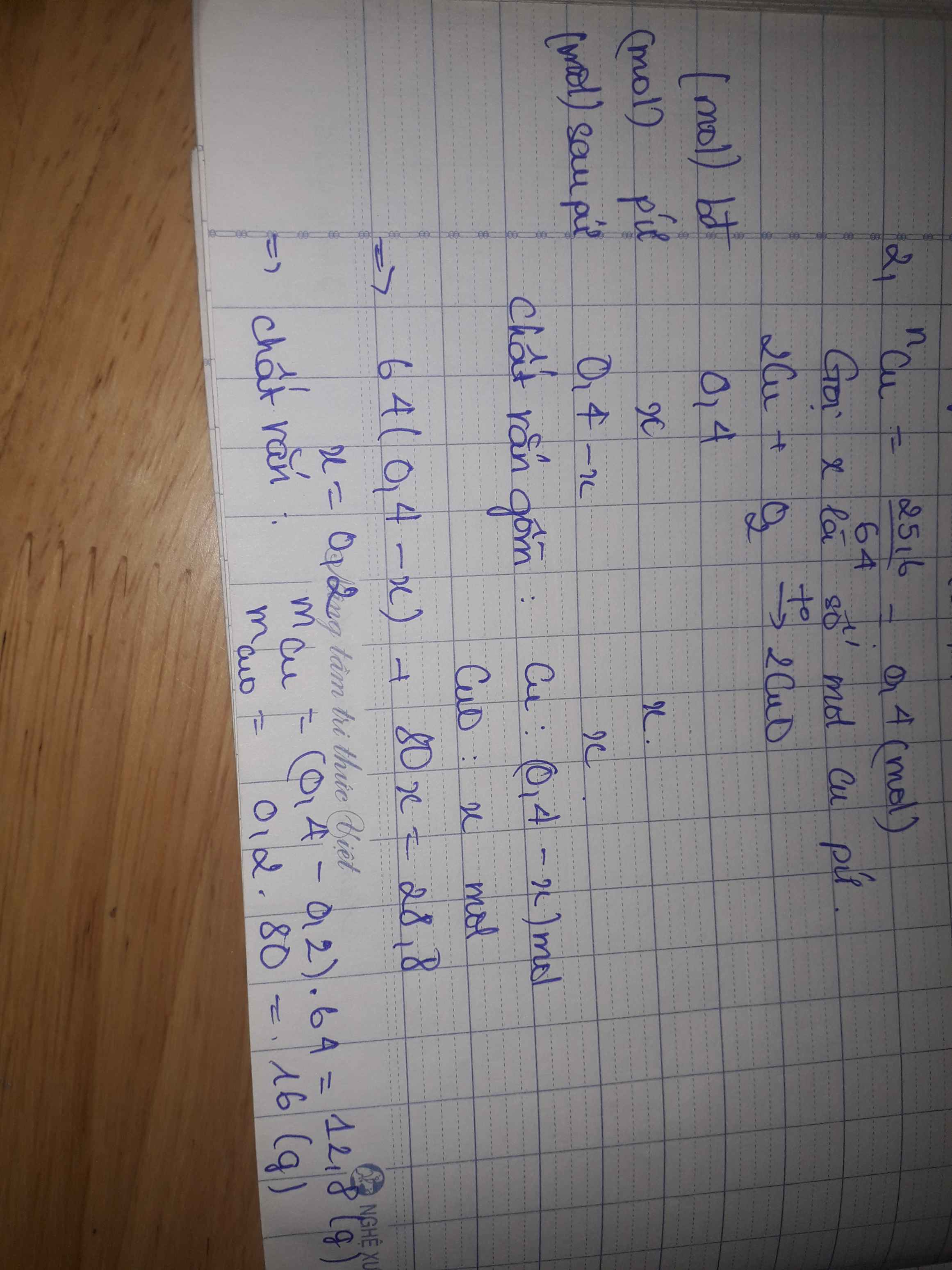Hãy nhập câu hỏi của bạn vào đây, nếu là tài khoản VIP, bạn sẽ được ưu tiên trả lời.

PTHH:
\(CuO+H_2\) \(\underrightarrow{t^o}\) \(Cu+H_2O\) \(\left(1\right)\)
\(Fe_2O_3+3H_2\) \(\underrightarrow{t^o}\) \(2Fe+3H_2O\) \(\left(2\right)\)
Số mol H2 là 0,6 mol
Gọi số mol H2 tham gia pư 1 là x mol \(\left(0,6>x>0\right)\)
Số mol H2 tham gia pư 2 là \(\left(0,6-x\right)mol\)
Theo PTHH 1:
\(n_{CuO}=n_{H_2}=x\left(mol\right)\)
Theo PTHH 2:
\(n_{Fe_2O_3}=\frac{1}{3}n_{H_2}=\left(0,6-x\right):3\left(mol\right)\)
Theo bài khối lượng hh là 40g
Ta có pt: \(80x+\left(0,6-x\right)160:3=40\)
Giải pt ta được \(x=0,3\)
Vậy \(n_{CuO}=0,3\left(mol\right);n_{Fe_2O_3}=0,1\left(mol\right)\)
\(\%m_{CuO}=\left(0,3.80.100\right):40=60\%\)
\(\%m_{Fe_2O_3}=\left(0,1.160.100\right):40=40\%\)
1)
PTHH: \(2Cu+O_2\) \(\underrightarrow{t^o}\) \(2CuO\)
x x
Gọi số mol Cu phản ứng là x mol ( x >0)
Chất rắn X gồm CuO và Cu
Ta có PT: 80x + 25,6 – 64x = 28,8
Giải PT ta được x = 0,2
Vậy khối lượng các chất trong X là:
\(m_{Cu}\) = 12,8 gam
\(m_{CuO}\) = 16 gam
2)
Gọi kim loại hoá trị II là A.
PTHH: \(A+2HCl\rightarrow ACl_2+H_2\)
Số mol \(H_2\)= 0,1 mol
Theo PTHH: \(n_A=n_{H_2}\)= 0,1 (mol)
Theo bài \(m_A\) = 2,4 gam \(\Rightarrow\) \(M_A\) = 2,4 : 0,1 = 24 gam
Vậy kim loại hoá trị II là Mg

1)
2Cu+O2---->2CuO
Áp dụng định luật bảo toàn khối lượng
m\(_{O2}=m_X-m_{Cu}=28,8-25,6=3,2\left(g\right)\)
n\(_{O2}=\frac{3,2}{32}=0,1\left(mol\right)\)
Theo pthh
n\(_{Cu}=2n_{O2}=0,2\left(mol\right)\)
m\(_{Cu}=0,2.64=12,8\left(g\right)\)
m\(_{Cu\left(trongX\right)}=25,6-12,8=12,8\left(g\right)\)
m\(_{CuO\left(trongX\right)}=28,8-12,8=16\left(g\right)\)
2)
Gọi tên KL là M
M+2HCl--->MCl2+H2
Ta có
n H2=\(\frac{2,24}{22.4}=0,1\left(mol\right)\)
Theo pthh
n\(_M=n_{H2}=0,1\left(mol\right)\)
M\(_M=\frac{2,4}{0,1}=24\)
-->M là Mg
Chúc bạn học tốt

giúp mình trả lời nhanh câu hỏi trên nhé mình cần rất gấp ngay bây giờ .giúp mình tí nhá cám ơn cả nhà nhiều

Cu + HCl → không phản ứng
PTHH: Fe + 2HCl → FeCl2 + H2
\(n_{Fe}=n_{H_2}=\frac{2,24}{22,4}=0,1\left(mol\right)\)
\(m_{Fe}=n.M=0,1.56=5,6\left(g\right)\)
→ \(m_{Cu}=10,4-5,6=4,8\left(g\right)\)
Vậy khối lượng đồng trong hỗn hợp ban đầu là 4,8 g và khối lượng sắt là 5,6 g
PTHH:
Fe + 2HCl → FeCl2 + H2
ta có
nH2=2,24/22,4=0,1(mol)
theo pt: => nFe =0,1(mol)
=> mFe = 0,1 . 56 = 5,6(g)
=> mCu= mhh - mFe = 10,4 − 5,6 = 4,8 (g)
Vậy khối lượng đồng là 4,8 g và khối lượng sắt là 5,6 g


1. nCu = m/ M = 0,4 ( mol )
PTHH : 2Cu + O2 -> 2CuO
...............0,4................0,4.....
=> mCuO = n.M = 32g > 28,8 g .
=> Cu dư .
- Gọi mol Cu và CuO trong X là x và y :
Theo bài ra ta có : \(\left\{{}\begin{matrix}x+y=0,4\\64x+80y=28,8\end{matrix}\right.\)
=> x = y = 0,2 (mol )
=> mCu = n.M = 12,8 g, mCuO = n.M = 16 ( g )
Vậy ..
2, - Gọi kim loại cần tìm là X .
\(X+2HCl\rightarrow XCl_2+H_2\)
Theo PTHH : \(n_X=n_{H2}=\dfrac{2,4}{M}=\dfrac{V}{22,4}=0,1\)
=> M = 24 ( TM )
Vậy X là Mg .